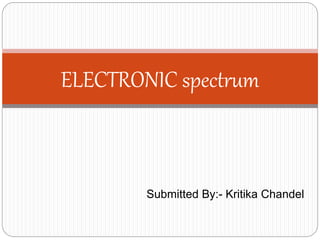
Electronic Spectrum
- 1. Submitted By:- Kritika Chandel ELECTRONIC spectrum
- 2. INTRODUCTION ULTRAVIOLET – VISIBLE SPECTROSCOPY It is the measurement of absorption of a beam of light after it passes through a sample or after reflection from a sample surface. Absorption measurements can be at a single wavelength or over an extended spectral range. Spectrum which results due to energy changes in electronic, vibrational, rotational levels is called absorption spectrum.
- 3. PRINCIPLE It is based on the absorption of ultraviolet light or visible light by chemical compounds, which results in the production of distinct spectra. When the matter absorbs the light, it undergoes excitation and de-excitation, resulting in the production of a spectrum.
- 4. BEER LAMBERT LAW Beer’s Law :- The intensity of a beam of monochromatic light decreases exponentially with the increase in concentration of the absorbing substance. Lambert’s Law :- When a beam of light is allowed to pass through a medium, the rate of decrease of intensity with the thickness of medium is directly proportional to the intensity of the light.
- 5. As per the Beer-Lambert law, the greater the number of absorbing molecules (that have the ability to absorb light of a specific wavelength), the greater the extent of absorption of the radiation.
- 6. PRESENTATION OF THE SPECTRUM In UV spectrum, energy required for electronic transition is higher than Infrared and Microwave. Electronic transitions tend to accompany both rotational and vibrational transitions and that’s why its spectrum has broad band.
- 9. SELECTION RULES In electronic spectroscopy there are two selection rules which determine whether or not transitions are formally allowed. 1) Spin selection rule: ∆S = 0 Allowed transitions : Singlet —› Singlet or Triplet —› Triplet Forbidden transitions: Singlet —› Triplet or Triplet —› Singlet
- 10. 2) Symmetry selection rule: It says that transitions between states of the same symmetry with respect to inversion are forbidden. Symmetry allowed transitions : g —› u or u —› g Symmetry forbidden transitions : g —› g or u —› u g stands for gerade – Compound with a centre of symmetry u stands for ungerade – Compound without a centre of symmetry
- 12. pi bonding and pi antibonding
- 13. Sigma bonding and sigma antibonding
- 14. TYPES OF ELECTRONIC TRANSITIONS σ ⇾ σ* Transition :An electron in a bonding σ orbital of a molecule is excited to the corresponding anti-bonding orbital by the absorption of radiation. To induce a σ ⇾ σ* transition it required LARGE ENERGY. Ex: Methane contain only single C-H bonds, it undergo only σ ⇾ σ* transition only, it gives absorption maximum at 125nm.
- 15. n⇾ σ* transition : In this type, compounds containing atoms with unshared electron pairs are undergo n ⇾ σ* transition. It require less energy than the σ ⇾ σ* type. Ex: Methyl chloride, Oxygen, Nitrogen. Most of the absorption peaks appearing below 200nm.
- 16. π ⇾ π* transitions : The transitions in which a pi electron is excited to antibonding pi orbital and occur in unsaturated compounds and aromatic rings. Ex : Ethylene, Propene, Propyne, Carbonyl. n ⇾ π* transitions : In this transition, unsaturated compounds containing unshared pair of electrons undergo n to π∗ transitions. Out of all transitions, this transition requires minimum energy and hence occurs at longer wavelength. Ex: C=O, C=S and N=O The energy requirement order for excitation for different transitions is as follows. n→π*< π→π*< n→σ*< σ→σ*
- 17. Related Questions 1) The types of transitions possible in UV-visible region for compound with molecular formula C 2H 4O are σ ⇾ σ* n⇾ σ* π ⇾ π* n ⇾ π* 2) The units for absorbance are (A) L mol -1 cm -1 (B) g mol -1 cm -1 (C) Mol. L -1.cm =1 (D) None of the above
- 18. 3) Energies required for the following transitions in increasing order P. σ ⇾ σ* Q. n⇾ σ* R. π ⇾ π* S. n ⇾ π* P<Q<R<S Q<S<R<P S<R<Q<P P<S<R<Q 4) The possible transitions in UV-visible region for this compound will be σ →σ * n→π *, π→π * σ→σ *, n→π *
- 19. 5) Which of the following statement is not correct ? (A) Absorptivity changes with the intensity of the light (B) Absorbance is independent of intensity of the light (C) Absorbance has no units (D) Absorptivity is a constant and depends on the nature of the molecule
- 20. ANSWERS 1. π ⇾ π* and n ⇾ π* 2. Absorbance depends on the nature of the solution and thus has no unit. 3. The energy requirement order for excitation for different transitions is as follows. n→π*< π→π*< n→σ*< σ→σ* 4. n→π *, π→π * 5. Absorbance is an intrinsic property.
- 21. THANK YOU